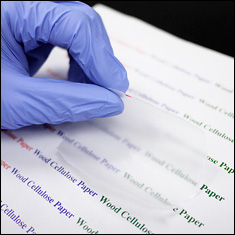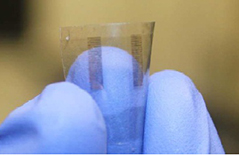News Story
Transparent Nanopaper Could Make Paper Electronics a “Thriving Technology”

Dr. Hongli Zhu.
Electronic devices of the future can be lighter, cheaper, more flexible, and produced without petroleum-based plastics. They would be as easy to recycle as paper, because they are made of paper.
Department of Materials Science and Engineering (MSE) postdoctoral research associate Hongli Zhu says this is entirely possible, though not with the kind of paper most of us use every day. Zhu is part of a team at the University of Maryland Energy Research Center developing transparent “nanopaper,” a material that looks more like a sheet of plastic than something made from wood. The group has re-engineered cellulose fibers into a paper with physical, optical and mechanical properties that make it an ideal surface on which to create organic solar cells, antennas, chemical and biological sensors, and printed circuitry for electronic devices. It could even be used as an antiglare touchscreen for tablets and computers.
Zhu, a member of MSE assistant professor and Maryland NanoCenter member Liangbing Hu’s research group, recently explained how it all works in first-authored a state-of-the-field review of transparent paper research in Energy & Environmental Science, and at the fall meeting of the Materials Research Society, where she was nominated for the Best Poster Award.
While ordinary paper has been used in experimental electronic devices, it must be coated or laminated to compensate for its rough surface, low tensile strength, and opaqueness. This extra processing is too slow and expensive to use in producing printed electronics.
A paper’s properties are dictated in large part by the fibers from which it is made. At an average length of 20 microns, ordinary cellulose fibers create a surface texture far too rough to support micro- and nanoscale structures. Zhu and her colleagues “detangle” or “unravel” the fibers and recreate a sheet of paper from them instead–much in the way running something through a blender gives it a smoother texture.
The nanoscale fiber construction reduces the paper’s ability to scatter light, making it 90-95% transparent, and gives it a surface as smooth as plastic. It is inherently stronger than ordinary paper due to the increased number of hydrogen bonds between its densely packed, tiny fibers. Its optical qualities can be adjusted during manufacture to reduce glare or to control the transmission or absorption of light.
The application of a thin coating of carbon nanotubes makes the nanopaper even stronger–and makes it highly conductive. The Hu Group has also created a version that incorporates a layer of silver nanowires for conductivity, and surface oxidation for the strengthening.
Zhu believes these recent advances will transform paper electronics from a “dormant idea” to a “thriving technology.”
Cellulose is abundant, easy to handle and process, biodegradable, inexpensive, and easily printed, which makes it an ideal substitute for silicon in printed electronic circuits, she said.
For More Information:
Visit the Bing Research Group web site
“A Battery Made of Wood?” Learn about another project Zhu has worked on, including a video of her explaining how the research team took its inspiration from trees.
“Tracing paper boost for solar cells.” James Urquhart covers another use for the team’s transparent paper for Chemistry World.
Hongli Zhu, Zhiqiang Fang, Colin Preston, Yuanyuan Lia and Liangbing Hu. Transparent paper: fabrications, properties, and device applications. Energy Environ. Sci., 2014, 7, 269-287. Abstract
Z. Fang, H. Zhu, C. Preston, X. Han, Y. Li, S. Lee, X. Chai, G. Chen and L. Hu. Highly transparent and writable wood all-cellulose hybrid nanostructured paper. J. Mater. Chem. C, 2013, 1, 6191-6197. Abstract
Published January 27, 2014














